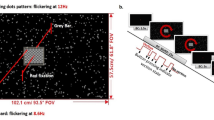Summary
To assess central nervous system effects and visual fatigue induced by work with visual display terminals (VDT), symptom frequency was assessed and visual evoked potential (VEP), critical flicker fusion (CFF) and near-point distance were measured in 24 female keypunchers before and after 2.5 h of VDT work and in 6 non-VDT-exposed subjects at the same intervals. Each keypuncher had been engaged in data entry for 1–7 (mean, 4) years. After VDT work, the number of complaints of subjective fatigue as well as an objective measure of near-point distance were significantly increased as compared with those before work; also, the N75, P100 and N145 latencies of VEP were significantly prolonged. The change of P100 latency during VDT work was inversely correlated with the number of years worked in data entry. No significant change was seen in any of these tests in the non-VDT-exposed subjects. The changes in N75 latency and subjective fatigue related to drowsiness and dullness in the keypunchers were significantly larger than those in the non-VDT-exposed subjects. The CFF was significantly lower in keypunchers than in non-VDT-exposed subjects in both the first and the second tests. These data suggest that VDT work is associated with impairment of the visual nervous system function, that VEP latencies appear to be a sensitive indicator of visual fatigue, at least transiently, and that CFF appears to be a good parameter for estimations of chronic visual fatigue.
Similar content being viewed by others
References
Araki S, Murata K, Aono H (1987) Central and peripheral nervous system dysfunction in workers exposed to lead, zinc and copper: a follow-up study of visual and somatosensory evoked potentials. Int Arch Occup Environ Health 59:177–187
Baschera P, Grandjean E (1979) Effects of repetitive tasks with difficulty on critical fusion (CFF) and subjective state. Ergonomics 22:377–385
Bergqvist U (1989) Possible health effects of working with VDUs. Br J Ind Med 46:217–221
Gould JD, Grischkowsky N (1984) Doing the same work with hard copy and with cathode-ray tube (CRT) computer terminals. Hum Factors 26:323–337
Gulmann NC, Hammerberg PE, Jensen LB, Sommerbeck KW, Ørbaek K (1979) Visual evoked potential in patients with cerebral asthenopia. Acta Neurol Scand 59:324–330
Iwasaki T, Kurimoto S (1988) Eye-strain and changes in accommodation of the eye and in visual evoked potential following quantified visual load. Ergonomics 31:1743–1751
Knave BG, Wibom RI, Voss M, Hedstrom LD, Berqgvist UOV (1985) Work with video display terminals among office employees: I. Subjective symptoms and discomfort. Scand J Work Environ Health 11:457–466
Kumashiro M, Mikami K, Hasegawa T (1984) Effects of visual and mental strain on VDT performance (in Japanese, with English abstract). Jpn J Ind Health 26:105–111
Kuorinka I (1981) Discomfort and motor skills in semi-paced tasks. In: Salvendy G, Smith MJ (eds) Machine pacing and occupational stress. Taylor Francis Ltd, New York, pp 267–272
Lueders H, Lesser RP, Klem G (1980) Pattern evoked potentials. In: Henry CE (ed) Current clinical neurophysiology: update on EEG and evoked potentials. Elsevier, New York, pp 467–526
Misawa T, Shigeta S (1986) An experimental study of work load on VDT performance: II. Effects of difference in input devices (in Japanese, with English abstract). Jpn J Ind Health 28:462–469
Misawa T, Yoshino K, Shigeta S (1984) An experimental study on the duration of a single spell of work on VDT performance (in Japanese, with English abstract). Jpn J Ind Health 26:296–302
Murata K, Araki S, Aono H (1987) Visual and brainstem auditory evoked potentials in lead-exposed workers (in Japanese, with English abstract). Jpn J EEG EMG 15:16–21
Ossenblok P, Spekreijse H (1988) Visual evoked potentials as indicators of the workload at visual display terminals. Ergonomics 31:1437–1448
Simonson E, Brozek J (1952) Flicker fusion frequency: background and applications. Physiol Rev 32:349–378
Sokol S (1986) Visual evoked potentials. In: Aminoff MJ (ed) Electrodiagnosis in clinical neurology, 2nd edn. Churchill Livingstone, New York, pp 441–466
Sugita M, Minowa H, Ishii M, Etoh R (1986) Factors affecting subjective symptoms of VDT workers (in Japanese, with English abstract). Jpn J Ind Health 28:409–419
World Health Organization (1987) Visual display terminals and workers′ health. (Offset publication 99) WHO, Geneva
Yoshitake H (1978) Three characteristic patterns of subjective fatigue symptoms. Ergonomics 21:231–233
Author information
Authors and Affiliations
Rights and permissions
About this article
Cite this article
Murata, K., Araki, S., Kawakami, N. et al. Central nervous system effects and visual fatigue in VDT workers. Int. Arch Occup Environ Heath 63, 109–113 (1991). https://doi.org/10.1007/BF00379073
Received:
Accepted:
Issue Date:
DOI: https://doi.org/10.1007/BF00379073




